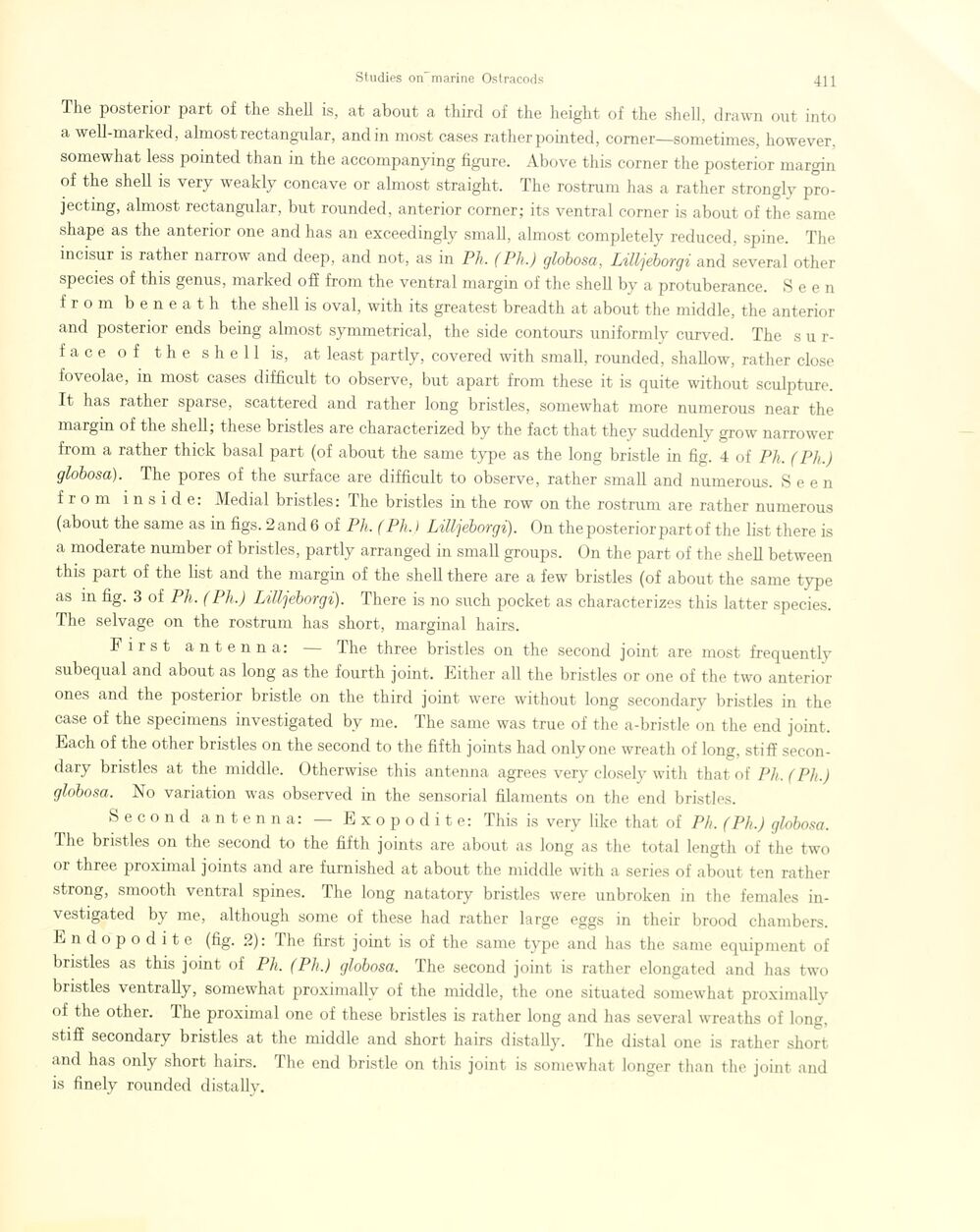
Full resolution (JPEG) - On this page / på denna sida - Sidor ...

<< prev. page << föreg. sida << >> nästa sida >> next page >>
Below is the raw OCR text
from the above scanned image.
Do you see an error? Proofread the page now!
Här nedan syns maskintolkade texten från faksimilbilden ovan.
Ser du något fel? Korrekturläs sidan nu!
This page has never been proofread. / Denna sida har aldrig korrekturlästs.
The posterior part of the shell is, at about a third of the height of the shell, drawn out into
a well-marked, almostrectangular, andin most cases ratherpointed, corner—sometimes, liowever.
somewhat less pointed than in the accompanying figure. Above this corner the posterior margin
of the shell is very weakly concave or almost straight. The rostrum has a rather strongly
pro-jecting, almost rectangular, but rounded, anterior corner; its ventral corner is about of the same
shape as the anterior one and has an exceedingly small, almost completely reduced, spine. The
incisur is rather narrow and deep, and not, as in Pli. (Pli.) globosa, Lilljéborgi and several other
species of this genus, marked off from the ventral margin of the shell by a protubérance. Seen
from beneath the shell is oval, with its greatest breadth at about the middle, the anterior
and posterior ends being almost symmetrica!, the side contours uniformly curved. The
surface of the shell is, at least partly, covered with small, rounded, shallow, rather close
foveolae, in most cases difficult to observe, but apart from these it is quite without sculpture.
It has rather sparse, scattered and rather long bristles, somewhat more numerous near the
margin of the shell; these bristles are characterized by the faet that they suddenly grow narro wer
from a rather thick basal part (of about the same type as the long bristle in fig. 4 of Pli. ( Pli.)
globosa). The pores of the surface are difficult to observe, rather small and numerous. Seen
from inside: Medial bristles: The bristles in the row on the rostrum are rather numerous
(about the same as in figs. 2 and 6 of Ph. (Ph.) Lilljéborgi). On the posterior part of the list tliere is
a moderate number of bristles, partly arranged in small groups. On the part of the shell between
this part of the list and the margin of the shell there are a few bristles (of about the same type
as in fig. 3 of Ph. (Ph.) Lilljéborgi). There is no such pocket as characterizes this latter species.
The selvage on the rostrum has short, marginal hairs.
First antenna: — The three bristles on the second joint are most frequently
subequal and about as long as the fourth joint. Either all the bristles or one of the two anterior
ones and the posterior bristle on the third joint were without long secondary bristles in the
case of the specimens investigated by me. The same was true of the a-bristle on the end joint.
Each of the other bristles on the second to the fiftli joints had only one wreath of long, sti ff
secondary bristles at the middle. Otherwise this antenna agrees very closely with that of Pli.(Ph.)
globosa. No variation was observed in the sensorial filaments on the end bristles.
Second antenna: — Exopodite: This is very like that of Pli. (Pli.) globosa.
The bristles on the second to the fifth joints are about as long as the total length of the two
or three proximal joints and are furnished at about the middle with a series of about ten rather
strong, smooth ventral spines. The long natatory bristles were unbroken in the females
investigated by me, although some of these had rather large eggs in their brood chambers.
Endopodite (fig. 2): The first joint is of the same type and has the same equipment of
bristles as this joint of Ph. (Pli.) globosa. The second joint is rather elongated and has two
bristles ventrally, somewhat proximallv of the middle, the one situated somewhat proximally
of the other. The proximal one of these bristles is rather long and has several wreaths of long,
stiff secondary bristles at the middle and short hairs distally. The distal one is rather short
and has only short hairs. The end bristle on this joint is somewhat longer than the joint and
is finely rounded distally.
<< prev. page << föreg. sida << >> nästa sida >> next page >>